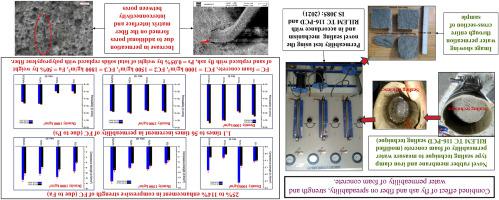强度和渗透性是泡沫混凝土 (FC) 各种应用中关注的两个关键特性。众所周知,这些特性高度依赖于 FC 的密度、混合成分和微观结构等参数。在提高FC强度和渗透特性的各种措施中,粉煤灰和聚丙烯纤维的掺入已被各种研究证明是有效的解决方案。就渗透性而言,虽然已经提出通过各种方法测量空气/水渗透性,但通常这种测量仅限于3巴的压力。对于更高的压力(如 Codal 规定中所建议的),无法进行有限的工作。在本文中,铺展性、渗透性、对用 F 级粉煤灰替代 50% 的砂子并掺入聚丙烯纤维后的 FC 的抗压强度和劈裂拉伸强度进行了系统研究。为了测量较高压力(>3 bar)下的渗透率,本工作尝试使用新型密封机构,该密封机构使用 5 mm 厚的橡胶膜作为密封剂,以铁螺旋筒和夹具作为外壳。本研究是首次利用上述密封机制测量较高压力下 FC 渗透率的研究。此外,关于含有飞灰(作为填料)和聚丙烯纤维的燃料电池的渗透行为的文献很少。根据目前的发现,特别是在较低密度的混合物中(例如密度 1000 kg/m 为了测量较高压力(>3 bar)下的渗透率,本工作尝试使用新型密封机构,该密封机构使用 5 mm 厚的橡胶膜作为密封剂,以铁螺旋筒和夹具作为外壳。本研究是首次利用上述密封机制测量较高压力下 FC 渗透率的研究。此外,关于含有飞灰(作为填料)和聚丙烯纤维的燃料电池的渗透行为的文献很少。根据目前的发现,特别是在较低密度的混合物中(例如密度 1000 kg/m 为了测量较高压力(>3 bar)下的渗透率,本工作尝试使用新型密封机构,该密封机构使用 5 mm 厚的橡胶膜作为密封剂,以铁螺旋筒和夹具作为外壳。本研究是首次利用上述密封机制测量较高压力下 FC 渗透率的研究。此外,关于含有飞灰(作为填料)和聚丙烯纤维的燃料电池的渗透行为的文献很少。根据目前的发现,特别是在较低密度的混合物中(例如密度 1000 kg/m 本研究是首次利用上述密封机制测量较高压力下 FC 渗透率的研究。此外,关于含有飞灰(作为填料)和聚丙烯纤维的燃料电池的渗透行为的文献很少。根据目前的发现,特别是在较低密度的混合物中(例如密度 1000 kg/m 本研究是首次利用上述密封机制测量较高压力下 FC 渗透率的研究。此外,关于含有飞灰(作为填料)和聚丙烯纤维的燃料电池的渗透行为的文献很少。根据目前的发现,特别是在较低密度的混合物中(例如密度 1000 kg/m3)在56天龄期进行测试,用F级粉煤灰替代50%的细骨料(按重量计)导致抗压强度提高114%,渗透率降低69%。此外,与不含飞灰和聚丙烯纤维的 FC 混合物相比,用聚丙烯纤维(按重量计)替代总固体量 0.05% 的混合物的抗压强度降低了 25%,渗透性增加了 500%。第三,考虑添加粉煤灰和聚丙烯纤维的混合物,发现从强度角度来看,粉煤灰的效果比纤维更显着。然而,从渗透性的角度来看,纤维由于对 FC 微观结构的影响更大,因此可以显着控制渗透性。
 "点击查看英文标题和摘要"
"点击查看英文标题和摘要"
Combined effect of fly ash and fiber on spreadability, strength and water permeability of foam concrete
Strength and permeability are the two critical properties of interest for various applications of foam concrete (FC). These properties are well known to be highly dependent on parameters such as density, mix composition and microstructure of FC. Among various measures to enhance the strength and permeation characteristics of FC, incorporation of fly ash and polypropylene fiber has been proven to be effective solutions by various studies. In terms of permeability, though the measurement of air/water permeability has been suggested by various methods, usually such measurements are limited to a pressure of 3 bar. For higher pressures (as recommended in codal provisions) no to limited work is available. In this paper, variation in spreadability, permeability, compressive strength and split tensile strength of FC due to replacement of 50% of sand with Class F fly ash and incorporation of polypropylene fiber is investigated on a systematic basis. For the measurement of permeability at higher pressures (>3 bar), use of novel sealing mechanism using 5 mm thick rubber membrane as sealant with iron spiral cylinder and clamp as casing, is attempted in this work. The present study is first of kind of study using the above-mentioned sealing mechanism for measurement of permeability of FC at higher pressures. Further, only scanty literature is available on permeation behavior of FC with fly ash (as filler) and polypropylene fiber. As per the present findings, particularly in lower density mixes (say density 1000 kg/m3) tested at age of 56 days, replacement of 50% of fine aggregate (by weight) by Class F fly ash results in 114% enhancement in compressive strength and 69% reduction in permeability. In addition, mixes with 0.05% of total solids replaced with polypropylene fiber (by weight) show 25% reduction in compressive strength and 500% increase in permeability in comparison to FC mixes without fly ash and polypropylene fibers. Thirdly, considering mixes with addition of fly ash and polypropylene fibers both, it is found that the effect of fly ash is more predominant from strength perspective than fiber. From permeability perspective however, the fibers control the permeability significantly due to their higher impact on microstructure of FC.




















































 京公网安备 11010802027423号
京公网安备 11010802027423号